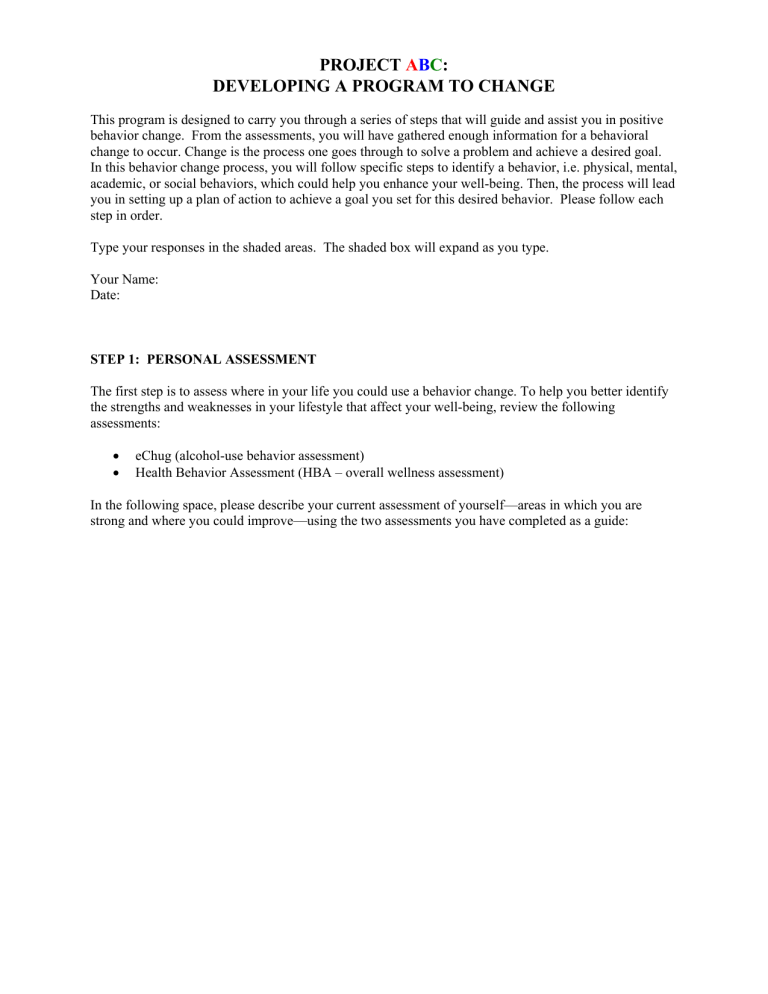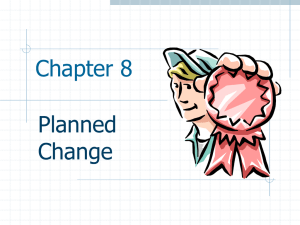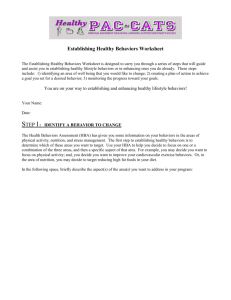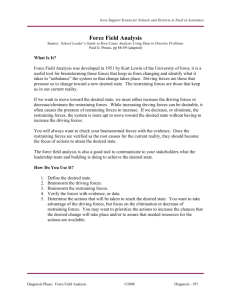PROJECT : DEVELOPING A PROGRAM TO CHANGE A

PROJECT
A B C
:
DEVELOPING A PROGRAM TO CHANGE
This program is designed to carry you through a series of steps that will guide and assist you in positive behavior change. From the assessments, you will have gathered enough information for a behavioral change to occur. Change is the process one goes through to solve a problem and achieve a desired goal.
In this behavior change process, you will follow specific steps to identify a behavior, i.e. physical, mental, academic, or social behaviors, which could help you enhance your well-being. Then, the process will lead you in setting up a plan of action to achieve a goal you set for this desired behavior. Please follow each step in order.
Type your responses in the shaded areas. The shaded box will expand as you type.
Your Name:
Date:
STEP 1: PERSONAL ASSESSMENT
The first step is to assess where in your life you could use a behavior change. To help you better identify the strengths and weaknesses in your lifestyle that affect your well-being, review the following assessments:
• eChug (alcohol-use behavior assessment)
•
Health Behavior Assessment (HBA – overall wellness assessment)
In the following space, please describe your current assessment of yourself—areas in which you are strong and where you could improve—using the two assessments you have completed as a guide:
STEP 2: SELECTING A TARGET BEHAVIOR AND A GOAL
The next step is to identify and describe a behavior you wish to change and the goal or outcome you wish to accomplish. Here are some guidelines for selecting the target behavior and the corresponding goal or outcome.
Is the behavior something you really care about?
•
Can you say that changing this behavior is important to you?
•
Can you say that you will likely be healthier or better off if you change this behavior?
•
If needed, would you be willing to spend the money necessary to change this behavior?
Is it something you are internally motivated to do?
•
Be sure the behavior and the goal you set for that behavior are intimately yours and not an agenda that someone else has for you.
Are you able to be specific about the behavior you want to change and the related goal or outcome?
•
Select a specific part of your lifestyle you want to work on rather than a big, abstract issue that everyone could be interested in.
Examples of behaviors that are too big and general are: Lose weight, feel healthier, drink less alcohol, and reduce anger.
Examples of behaviors and goals that are clear and more specific are: improve physical fitness by exercising at least three days a week for 30 minutes or improve my emotional control by doing breathing exercises at least four times a day.
Is it possible that you can influence the situation you are concerned about?
•
For example: You could choose to have more quiet time in your day, but living with and around others could limit the amount of quiet time that is possible.
Is your goal something that makes you stretch beyond your present level, but is not out of your reach?
•
For example: You could increase your study time 10 – 20%, but may not have 3 extra hours a day.
You could increase your strength 15%, as measured by a bench press, in the next 60 days, but it
• would be highly unlikely that you could increase it 50%.
Is your goal something you can count or measure?
For example: A countable goal could be to create a “to do” list and then prioritize the activities on the list to reorganize it as a “do-able” list each morning. Thus, you can count a yes or no for each day you make a “do-able” list and also count the number of “do-able” tasks you accomplished in a day.
In the space below, identify your target behavior and describe the goal you want to achieve.
NOTE: After identifying your target behavior and goal, go through the above criteria for selecting a target behavior and goal. If you answer no to any of these questions, you may want to consider choosing another behavior or setting a more achievable goal for your behavior.
STEP 3: MAKING A GOAL STATEMENT
Most behavioral goals can be rephrased so that they can describe two things:
A. The behavior as it is now (e.g., I only study five hours a week.)
B. The behavior as you would like it to be—the goal (e.g., I want to study ten hours a week.)
Restate your behavioral goal briefly, indicating the direction of change you desire.
Poor: I want to improve the way I study.
Better: I want to implement a system to better plan and organize my study time.
Poor: I go along with friends’ ideas too much; I want to stand up for myself.
Better: I want to increase my assertiveness while interacting with friends by doing at least one assertive behavior a day.
Restate your behavioral goal to indicate the positive direction of change:
STEP 4: COMPLETING A FORCE FIELD ANALYSIS
Most behavioral changes can be understood in terms of the forces that help you achieve your goal and the forces that prevent you from achieving your goal. For example, some forces will improve your overall physical fitness, such as regular cardiovascular exercise, good nutrition, and regular sleep. These are called driving forces . Other factors will tend to decrease your fitness, such as excessive alcohol consumption, too many sweets, and watching television on the couch. These are called restraining forces .
Driving Forces that help you reach your goal.
Desire for energy and fitness
Fast Food
Enjoy eating with family and friends
Eating by Myself Eating Late at Night
Restraining forces that prevent you from reaching your goal.
Improve Health
Poor Planning
Goal Attainment :
Improve Nutritional level of eating
In the spaces below, write out the DRIVING FORCES and the RESTRAINING FORCES that could affect your progress toward your goal. What are the driving and restraining forces affecting the situation you want to improve? Use this as brainstorming, coming up with as many ideas as possible. Consider personality factors, physical resources, social pressures, other responsibilities, feelings, or other conditions. Again, list everything that comes to mind without being selective. You may weed out irrelevant items later.
List Driving Forces that will help you reach your goal:
List Restraining Forces that could prevent you from reaching your goal:
STEP 5: PRIORITIZE THE MOST IMPORTANT DRIVING AND RESTRAINING FORCES
Now review the two lists and pick out those forces which seem to be the most important right now and which you might be able to affect constructively. Identify the two or three most important driving and restraining forces from your list and write them in the spaces below.
Most Important Driving Forces
Most Important Restraining Forces
[FIELD]
STEP 6: ACTION STEPS FOR RESTRAINING FORCES
Now, for each of your most important restraining forces, list some possible action steps you can plan and carry out to reduce the effect of the force or to eliminate it completely. For example: If a restraining force against morning study is a tendency to sleep through your alarm, you might get a louder alarm, go to bed earlier, or have someone come in to make sure you wake up. Again brainstorm, listing as many possibilities as you can. List below the most important restraining forces you have and brainstorm action steps to minimize them:
Restraining Force 1:
Action steps:
A.
B.
C.
Restraining Force 2:
Action steps:
A.
B.
C.
Restraining Force 3:
Action steps:
A.
B.
C.
STEP 7: ACTION STEPS FOR DRIVING FORCES
Now, for each of the most important driving forces, make a list of actions that will support these forces.
For example, if a driving force is encouragement from your friends, then you might write as an action step: Writing an agreement with a friend and sharing the celebration of your achievement; asking them to check with you by calling once a week; or you could let several friends know what you are trying to do and ask for their support. Outline these on the next pages.
Driving Force 1:
Action steps:
A.
B.
C.
Driving Force 2:
Action steps:
A.
B.
C.
Driving Force 3:
Action steps:
A.
B.
C.
Now you have organized the major steps for achieving change!
[no field necessary here.]
STEP 8: GOAL ATTAINMENT SCALE (A WAY TO MEASURE PROGRESS)
Goal attainment is a way to measure the progress you are making toward achieving your goal. We recommend that goal attainment use a 4-point scale. On this scale, Level 2 represents your present level of activity (behavior) before you start a program for change. Level 1 would represent getting worse—that is, your behavior goes in the opposite direction of your goal. Level 3 would represent a noticeable level of improvement, and Level 4 a significant level of improvement. It would look something like this:
Level 4 = significant improvement
Level 3 = noticeable improvement
Level 2 = present behavior
Walked for at least 30 minutes six days a week
Walked 30 minutes every other day
Walked 2 times a week for one month
Level 1 = noticeable decline Walked 20 minutes once every ten days
On the lines below write in a description of the behavior that will serve as the standard for attainment at each level of your goal attainment scale:
Level 4:
Level 3:
Level 2:
Level 1:
You may have more than one activity that you would set up in goal statements. You should do the same scaling for each specified goal:
STEP 9: MONITORING PROGRESS:
Use a daily or weekly tracking chart to record the progress of your behavior change goal. You should then evaluate your goal attainment at the end of the week, using the scale you devised in the previous step.
Example Tracking Chart
2/13 Walked for 30 minutes once this week.
Goal
Attainment
Score
1
Driving Forces
Utilized
Friend called me once to walk.
Restraining
Forces
Watched TV.
Played video games.
Possible Actions to overcome
Restraining Forces and/or enhance Driving Forces
Ask friend to call me every time he exercises. Reward myself with 30 minutes of video game playing after walking for 30 minutes.
REWARDING YOURSELF
•
Reward yourself appropriately for your accomplishments along the way to your goal.
•
At the beginning of your program, reward yourself after every successful action. Then when the target behavior becomes better established, reward yourself less frequently.
•
Have in mind rewards that your could give yourself after completing your short-term goal activities as well as accomplishing your long-term behavior change.
•
Rewards can be anything from savoring feelings of satisfaction, to spending time with friends, to a new music CD.
•
Just make sure rewards are appropriate to the accomplishment and that they don’t create a problem situation for you.
MAKING ADJUSTMENTS
•
Review your tracking chart after you are into your program for a week or two. Assess how successfully your program is going. Determine if you need to reconsider the driving and restraining forces and the action steps you set up to either support or overcome them, respectively. You may find that restating your goal statement for your target behavior is necessary. Making adjustments is part of the process. Keep in mind, persistence is important to successful behavior change.
GOOD LUCK!




